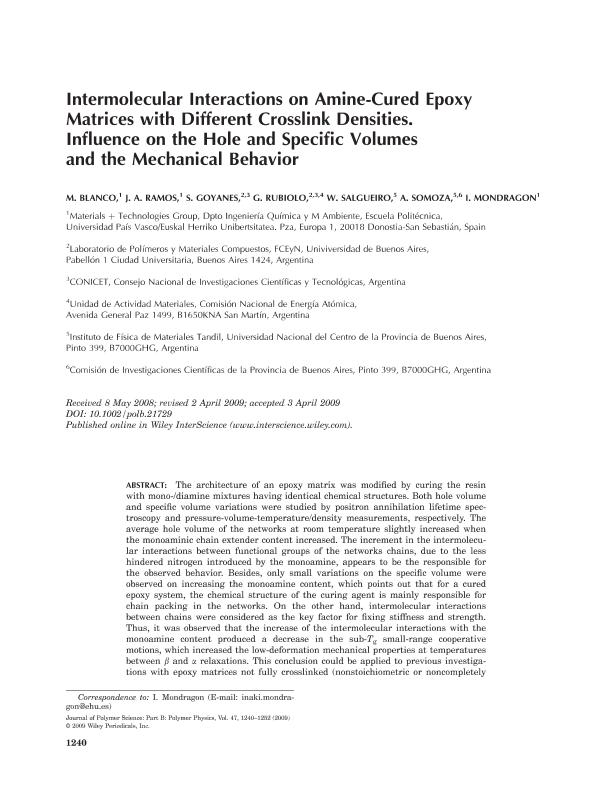Mostrar el registro sencillo del ítem
dc.contributor.author
Blanco, M.
dc.contributor.author
Ramos, J.A.
dc.contributor.author
Goyanes, Silvia Nair

dc.contributor.author
Rubiolo, Gerardo Hector

dc.contributor.author
Salgueiro, Walter Alberto

dc.contributor.author
Somoza, Alberto Horacio

dc.contributor.author
Mondragon, I.
dc.date.available
2018-10-01T17:05:56Z
dc.date.issued
2009-07
dc.identifier.citation
Blanco, M.; Ramos, J.A.; Goyanes, Silvia Nair; Rubiolo, Gerardo Hector; Salgueiro, Walter Alberto; et al.; Intermolecular interactions on amine-cured epoxy matrices with different crosslink densities. influence on the hole and specific volumes and the mechanical behavior; John Wiley & Sons Inc; Journal of Polymer Science Part B: Polymer Physics; 47; 13; 7-2009; 1240-1252
dc.identifier.issn
0887-6266
dc.identifier.uri
http://hdl.handle.net/11336/61370
dc.description.abstract
The architecture of an epoxy matrix was modified by curing the resin with mono-/diamine mixtures having identical chemical structures. Both hole volume and specific volume variations were studied by positron annihilation lifetime spec-troscopy and pressure-volume-temperature/density measurements, respectively. The average hole volume of the networks at room temperature slightly increased when the monoaminic chain extender content increased. The increment in the intermolecu-lar interactions between functional groups of the networks chains, ([0-9]{4})ue to the less hindered nitrogen introduced by the monoamine, appears to be the responsible for the observed behavior. Besides, only small variations on the specific volume were observed on increasing the monoamine content, which points out that for a cured epoxy system, the chemical structure of the curing agent is mainly responsible for chain packing in the networks. On the other hand, intermolecular interactions between chains were considered as the key factor for fixing stiffness and strength. Thus, it was observed that the increase of the intermolecular interactions with the monoamine content produced a decrease in the sub-Tgsmall-range cooperative motions, which increased the low-deformation mechanical properties at temperatures between b and a relaxations. This conclusion could be applied to previous investigations with epoxy matrices not fully crosslinked (nonstoichiometric or noncompletely cured formulations). Finally, it was found that fracture properties do not significantly depend either on the hole volume or on the intermolecular interactions. Fracture properties are more dependent on the crosslink density and the glass transition temperature. © 2009 Wiley Periodicals, Inc.
dc.format
application/pdf
dc.language.iso
eng
dc.publisher
John Wiley & Sons Inc

dc.rights
info:eu-repo/semantics/openAccess
dc.rights.uri
https://creativecommons.org/licenses/by-nc-sa/2.5/ar/
dc.subject
Crosslink Density
dc.subject
Crosslinking
dc.subject
Intermolecular Interactions
dc.subject
Microstructure-Properties Relationships
dc.subject
Positron Annihilation Lifetime Spectroscopy
dc.subject
Thermosets
dc.subject.classification
Astronomía

dc.subject.classification
Ciencias Físicas

dc.subject.classification
CIENCIAS NATURALES Y EXACTAS

dc.title
Intermolecular interactions on amine-cured epoxy matrices with different crosslink densities. influence on the hole and specific volumes and the mechanical behavior
dc.type
info:eu-repo/semantics/article
dc.type
info:ar-repo/semantics/artículo
dc.type
info:eu-repo/semantics/publishedVersion
dc.date.updated
2018-10-01T14:26:04Z
dc.journal.volume
47
dc.journal.number
13
dc.journal.pagination
1240-1252
dc.journal.pais
Estados Unidos

dc.journal.ciudad
Nueva York
dc.description.fil
Fil: Blanco, M.. Universidad del País Vasco; España
dc.description.fil
Fil: Ramos, J.A.. Universidad del País Vasco; España
dc.description.fil
Fil: Goyanes, Silvia Nair. Universidad de Buenos Aires; Argentina. Consejo Nacional de Investigaciones Científicas y Técnicas; Argentina. Consejo Nacional de Investigaciones Científicas y Técnicas. Oficina de Coordinación Administrativa Ciudad Universitaria. Instituto de Física de Buenos Aires. Universidad de Buenos Aires. Facultad de Ciencias Exactas y Naturales. Instituto de Física de Buenos Aires; Argentina
dc.description.fil
Fil: Rubiolo, Gerardo Hector. Consejo Nacional de Investigaciones Científicas y Técnicas; Argentina. Comisión Nacional de Energía Atómica; Argentina. Universidad de Buenos Aires; Argentina. Consejo Nacional de Investigaciones Científicas y Técnicas. Oficina de Coordinación Administrativa Ciudad Universitaria. Instituto de Física de Buenos Aires. Universidad de Buenos Aires. Facultad de Ciencias Exactas y Naturales. Instituto de Física de Buenos Aires; Argentina
dc.description.fil
Fil: Salgueiro, Walter Alberto. Universidad Nacional del Centro de la Provincia de Buenos Aires; Argentina
dc.description.fil
Fil: Somoza, Alberto Horacio. Provincia de Buenos Aires. Gobernación. Comisión de Investigaciones Científicas; Argentina. Universidad Nacional del Centro de la Provincia de Buenos Aires; Argentina. Consejo Nacional de Investigaciones Científicas y Técnicas. Oficina de Coordinación Administrativa Ciudad Universitaria. Instituto de Física de Buenos Aires. Universidad de Buenos Aires. Facultad de Ciencias Exactas y Naturales. Instituto de Física de Buenos Aires; Argentina
dc.description.fil
Fil: Mondragon, I.. Universidad del País Vasco; España
dc.journal.title
Journal of Polymer Science Part B: Polymer Physics

dc.relation.alternativeid
info:eu-repo/semantics/altIdentifier/doi/http://dx.doi.org/10.1002/polb.21729
Archivos asociados
